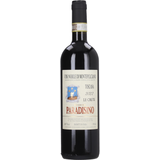Italian Wines - What You Should Know About Vino dall'Italia
🇮🇹 Italian Wines – A Timeless Delight with Rich Heritage! 🍷
When you think of Italian wines today, Chianti is just the beginning. Over the past few decades, Italy’s wine scene has undergone a remarkable transformation, with quality soaring to new heights. Since the Italian wine revolution of the 1960s, the country has firmly established itself at the forefront of the international wine world. Now more than ever, the pursuit of excellence drives Italian winemakers from north to south, where passion and dedication produce extraordinary wines. The result? A diverse range of high-quality Italian wines, rich in character and flavour. Discover everything you need to know about their unique qualities and what makes them so exceptional.
Quality levels of Italian wines
The highest quality category of Italian wines is the Denominazione di Origine Controllata e Garantita (DOCG). These wines have a controlled and guaranteed designation of origin and must be bottled directly in their respective growing regions. They can be recognized by the banderole on the neck of the bottle featuring the DOCG abbreviation. There are currently 74 DOCG wines, with Piedmont having the largest share, including prestigious wines such as Barolo.
Other quality levels include Denominazione di Origine Controllata (DOC), which comprises 333 wines, and Indicazione Geografica Tipica (IGT), covering 118 wines classified as regional wines. The IGT category also includes outstanding wines acclaimed by renowned critics such as Robert Parker and Falstaff.
A particular highlight is Chianti Classico, which also holds DOCG status. It is easily recognizable by the black rooster ("Gallo Nero") emblem on the bottle label, a symbol of tradition and exceptional quality.
The most important grape varieties in Italy
Italy is known for its wide selection of indigenous grape varieties. Here are some of the most important ones:
Red grape varieties:
🍷 Sangiovese - the basis for Chianti, Brunello di Montalcino & Vino Nobile di Montepulciano
🍷 Nebbiolo - main grape variety for Barolo and Barbaresco from Piedmont
primitivo - intense, fruity wines from Apulia (Zinfandel variety)
🍷 Montepulciano - intense, spicy red wines from Abruzzo
🍷 Barbera - juicy red wines with fine acidity from Piedmont
🍷 Corvina - the basis for Amarone and Valpolicella from Veneto
🍷 Nero d'Avola - intense, dark red wine from Sicily
🍷 Aglianico - structured, long-lasting wines from southern Italy
White grape varieties:
🍇 Trebbiano - fresh and fruity white wines, widespread in central Italy
pinot Grigio - light, fresh white wines from northern Italy
verdicchio - mineral white wines from the Marche region
🍇 Glera - prosecco grape variety for sparkling wines
🍇 Garganega - the basis for the popular Soave from Veneto
🍇 Vermentino - aromatic white wines from Liguria, Sardinia & Tuscany
🍇 Fiano - multi-layered, aromatic wines from Campania
These grape varieties illustrate the unique character of Italian wines. Each region has its specialities - discover the variety and find your favourite! 🍷✨
Bold red wines full of character
The Sangiovese grape is one of the most important and widely cultivated grape varieties in Italy. It serves as the foundation for iconic Tuscan wines such as Chianti Classico, Morellino di Scansano, and Vino Nobile di Montepulciano. It is also the key grape behind Brunello di Montalcino, a deep, full-bodied red renowned for its complexity and ageing potential.
Another well-known grape variety is Malvasia, which belongs to a diverse family of grapes. In Italy, it is often cultivated as a red wine grape and is widely used across different regions, primarily in cuvées blending multiple grape varieties. A unique speciality is Malvasia delle Lipari, a Sicilian liqueur wine traditionally enjoyed with dessert. However, Malvasia is not limited to still wines—it is also used in the production of sparkling wines.
A true symbol of Italian conviviality is Lambrusco, a lightly sparkling red wine made from the Lambrusco grape. This lively and refreshing wine is most commonly produced in Emilia-Romagna and, to a lesser extent, in Lombardy, perfectly capturing the essence of the Italian way of life.
Italian wines | Quality at all levels
The Italian wine revolution marked a dramatic transformation, elevating ordinary table wines into world-class masterpieces. The diverse aromas and flavours found in Italian wines make every tasting a fascinating experience.
In red wines, intense, fruity notes often emerge, accompanied by hints of leather, liquorice, and vanilla. But Italy is not just about reds—it is also home to exceptional sparkling wines. Among them, Prosecco stands out for its lightness and refreshing character. Italy maintains high-quality standards for Prosecco, with the Veneto and Friuli regions particularly renowned for their DOC Prosecco. The finest DOCG Proseccos come from Conegliano and Asolo, delighting wine lovers with their elegant effervescence and crisp freshness.
When it comes to white wines, those from the north are distinguished by their refined elegance, while Umbria's whites, known for their higher tannin content, beautifully capture the region’s unique character.
Anything goes as long as it’s fun!
Italian wines offer an incredible range of aromas and flavours, shaped by the diverse growing regions and grape varieties. Explore the world of Italian wines and let your taste buds be your guide—choose what delights you! A light, crisp white wine or refreshing Prosecco makes the perfect aperitif. Whether you pair a white or red wine with your meat dishes is entirely up to you; bold Italian whites can be just as complementary as fruity reds. To finish off a meal, indulge in a sweet vin santo or passito, a delightful way to wrap up the experience. But for now, raise a glass of beautifully sparkling Prosecco to welcome your guests!
Latest reviews
-
 3.5 (2)
3.5 (2)Clos Montblanc Masia les Comes Reserva 2017 Bio, 0,75 L
- Organic cuvée from Cabernet Sauvignon & Merlot
- 18 months barrique, now ideally matured
- Cassis, leather, roasted flavours & a hint of liquorice
€ 21,99 (€ 29,32 / L)Delivery by January 02
-
-
 4.0 (1)
4.0 (1)Pasqua Desire Lush &Zin, Primitivo Puglia IGP 2024, 0,75 L
- Intensely fruity red wine from Apulia
- Dark, powerful, with some residual sweetness
- Great companion for pizzas & burgers
€ 12,99 (€ 17,32 / L)Delivery by January 02
-
-
 4.0 (1)
4.0 (1)Podere Paradisino Le Crete Vino Nobile di Montepulciano 2022 DOCG, 0,75 L
- Traditional ageing over 24 months in wood
- Pure Sangiovese from Prugnolo-Gentile grapes
- Red berries, fine herbal spice and vibrant acidity
€ 20,99 (€ 27,99 / L)Delivery by January 02
-
-
 3.7 (9)
3.7 (9)Superwine OMG it's white, organic , 0,75 L
- 100% organic pecorino from Abruzzo, Italy
- Light, fruity and very accessible
- Elicits an "Oh my God" reaction
€ 9,99 (€ 13,32 / L)Delivery by January 02
-
Magazine Articles:
Discover 9wines Online:
-
Austria: Free standard delivery from € 49,90
-
We operate in a
climate-conscious manner. -
Free
returns Secure payments
with SSL encryption technology






